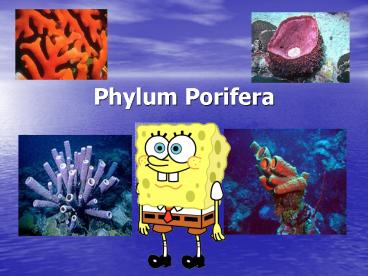Phylum Porifera - PowerPoint PPT Presentation
1 / 10
Title:
Phylum Porifera
Description:
Basically a sponge is a bunch of cells grouped together ... Finally, the remaining water leaves through the osculum (opening at top of sponge) ... – PowerPoint PPT presentation
Number of Views:459
Avg rating:3.0/5.0
Title: Phylum Porifera
1
Phylum Porifera
- A.K.A.
- Sponges
2
Sponges are an animal??
- Yes, they are!!!
- Sessile- sponges do not move anchored to one
place (rock or shell) - Sponges have no specialized tissues, organs, or
symmetry - Basically a sponge is a bunch of cells grouped
together - Live in shallow seas some in fresh water
3
General Characteristics
- Asymmetric (no true symmetry)
- Wide variety of colors
- Shapes- look like balls, discs, vases,
- branching shrubs, or small trees
- pore-bearing- look like a sack full of
- holes
4
Skeletal system
- Spongin- flexible protein
- Spicules- spikes/needles
- of calcium carbonate
Provide support
Spicules
Spongin
5
Digestion
- Filter feeder (heterotroph)- bring in small food
particles from water through porocytes (pores)
travels through spongocoel (central cavity) - Then the choanocytes trap digest food
- Next, amoebocytes carry nutrients to cells take
away waste - Finally, the remaining water leaves through the
osculum (opening at top of sponge)
6
Hey, nice choanocyte you got there!
7
Nervous and Circulatory System
- Sponges dont have them!!
8
Respiration
- Diffusion- oxygen from water moves into sponge
cells (high to low)
9
Reproduction
- Asexual- budding -small piece of sponge breaks
off from parent develops into a full grown
sponge - Sexual- hermaphrodites (produce eggs sperm at
different times) - sperm cells made by one sponge are carried to
another sponge by water once inside the sperm
fertilizes the egg - egg develops into a larvae attaches
itself to an object in the water where it
develops into an adult
10
Excretion
- Waste is collected by the amoebocytes through
diffusion it leaves through the osculum

